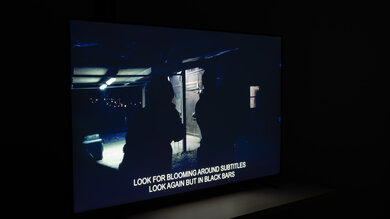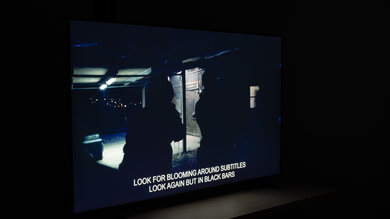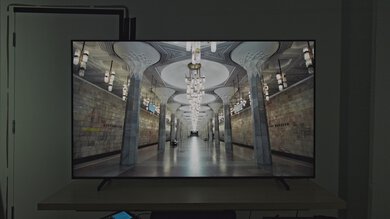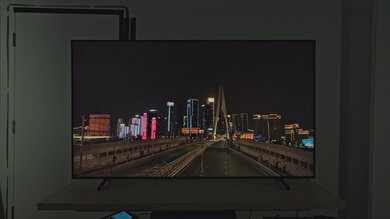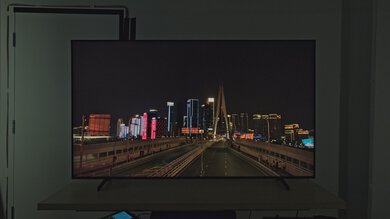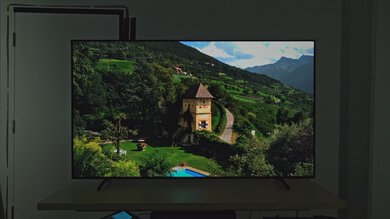The Samsung DU8000 is an entry-level model in Samsung's 2024 lineup and replaces the Samsung CU8000. It sits above the Samsung DU7000 and below Samsung's QLED lineup. It uses Samsung's AirSlim design, which is meant to provide a slim design that blends into your wall, and this TV comes with Samsung's proprietary Tizen OS, which has been updated to version 8.0 in 2024. The TV has a 20W 2.0 channel speaker system built-in and is available in a wide variety of sizes: anything from a small 43-inch model to a large 85-inch model. It's a basic TV but has some optional features like Motion Xcelerator to help smooth out motion and the Mega Contrast feature designed to automatically adjust the brightness and contrast of the image.
Our Verdict
The Samsung DU8000 is okay for mixed usage. It's best suited for watching movies or playing games in a dark room since it doesn't get bright enough to overcome glare in a bright room. HDR content lacks impact due to the TV's unremarkable contrast and inadequate HDR brightness, so blacks aren't deep at all when bright highlights are on screen, and highlights don't stand out the way they should. It also has a narrow viewing angle, so it's not a good option for watching shows or sports as a group, as anyone sitting to the side sees a degraded image. Fortunately, the TV has incredibly low input lag and a good response time, so it provides a responsive gaming or desktop experience, with minimal blur behind quick motion.
-
Incredibly low input lag for a responsive experience.
-
Good response time.
-
No local dimming to improve contrast.
-
Doesn't get very bright.
-
Poor low-quality content smoothing with noticeable artifacts present.
-
Calibration has almost no effect on the picture.
The Samsung DU8000 is okay for watching TV shows. It has sub-par SDR brightness and only decent reflection handling, so it doesn't overcome glare in a bright room. The TV's viewing angle is narrow, which means it's not a good choice if you like to move around your room while watching TV since the image degrades quickly from the sides. It also has unremarkable image processing, so low-quality streams and shows on DVD aren't as clear and sharp as they could be. Fortunately, Samsung's app store is loaded with all of the most popular streaming apps, so it's easy to find your favorite shows.
-
Easy to use interface and smart features.
-
Doesn't get very bright.
-
Narrow viewing angle.
-
Poor low-quality content smoothing with noticeable artifacts present.
-
Calibration has almost no effect on the picture.
The Samsung DU8000 is just alright for watching sports. Its uniformity is decent, but there's some noticeable dirty screen effect when watching sports with large areas of uniform color, like hockey or soccer. Due to its narrow viewing angle, it's not a good choice for hosting game days since anyone sitting off to the sides sees a degraded image. The TV only has decent reflection handling and doesn't get bright enough to overcome glare, so it's not a good option for watching the game in a bright room. Fortunately, the TV has a good response time, which means there's minimal blur behind quick-moving players and objects.
-
Good response time.
-
Doesn't get very bright.
-
Narrow viewing angle.
-
Poor low-quality content smoothing with noticeable artifacts present.
-
Calibration has almost no effect on the picture.
The Samsung DU8000 is satisfactory for playing video games. It has incredibly low input lag, so there's no discernable delay between your controller inputs and what happens on screen. The TV also has a good response time, which means there's minimal blur behind quick motion. If you regularly game in a dark room, the TV's unremarkable contrast delivers fairly deep blacks during dark scenes, but blacks become raised when bright highlights are on screen. Unfortunately, the TV doesn't get bright enough, and its reflection handling isn't good enough to overcome glare in a bright room.
-
Incredibly low input lag for a responsive experience.
-
Good response time.
-
Doesn't get very bright.
-
Poor low-quality content smoothing with noticeable artifacts present.
-
No VRR support and is limited to 60Hz.
-
Calibration has almost no effect on the picture.
The Samsung DU8000 is adequate for watching movies in a dark room. It has decent contrast that delivers fairly deep blacks in dark scenes, but since it lacks a local dimming feature, blacks become raised and washed out when bright highlights are on screen. HDR content lacks impact due to the TV's inadequate HDR brightness, so highlights don't stand out much at all. Unfortunately, the TV has poor low-quality content smoothing, which means low bitrate content is soft, with noticeable artifacts present.
-
Removes judder from 24p sources.
-
Easy to use interface and smart features.
-
No local dimming to improve contrast.
-
Doesn't get very bright.
-
No Dolby Vision or DTS audio support.
-
Poor low-quality content smoothing with noticeable artifacts present.
-
Calibration has almost no effect on the picture.
The Samsung DU8000 is passable for playing games in HDR, but that's mostly due to its SDR gaming capabilities, as HDR adds very little. Switching the TV to Game Mode makes no difference in dark scene performance, so you get incredibly low input lag with no noticeable delay between controller inputs and what happens on screen without sacrificing picture quality. The TV also has a good response time, so there's minimal blur behind fast motion. Unfortunately, the TV doesn't get bright enough in HDR to make highlights stand out, and its contrast is unremarkable, so HDR content lacks impact. The TV is also limited to 4k @ 60Hz and doesn't have VRR, so it's not a good option to pair with modern gaming consoles.
-
Incredibly low input lag for a responsive experience.
-
Good response time.
-
No local dimming to improve contrast.
-
Doesn't get very bright.
-
Poor low-quality content smoothing with noticeable artifacts present.
-
No VRR support and is limited to 60Hz.
The Samsung DU8000 is decent for use as a PC monitor. It has a good response time, so there's minimal blur behind fast cursor movements, and its incredibly low input lag provides a responsive desktop experience. On the other hand, the TV has a narrow viewing angle, so the sides of the screen don't stay uniform with the center when sitting close to the screen. Unfortunately, the TV only has decent reflection handling and doesn't get bright enough to overcome glare, so it's not a good option if you use your computer in a bright room. Although the TV can display chroma 4:4:4, we encountered an issue that intermittently displays it incorrectly.
-
Incredibly low input lag for a responsive experience.
-
Good response time.
-
Intermittent issue displaying chroma 4:4:4.
-
Doesn't get very bright.
-
Narrow viewing angle.
-
Poor low-quality content smoothing with noticeable artifacts present.
-
No VRR support and is limited to 60Hz.
-
Calibration has almost no effect on the picture.
- 6.9 Mixed Usage
- 6.5 TV Shows
- 6.8 Sports
- 7.2 Video Games
- 6.8 HDR Movies
- 7.5 HDR Gaming
- 7.2 PC Monitor
- Updated Apr 11, 2024: Review published.
- Updated Apr 05, 2024: Early access published.
- Updated Mar 25, 2024: Our testers have started testing this product.
- Updated Mar 21, 2024: The product has arrived in our lab, and our testers will start evaluating it soon.
- Updated Mar 12, 2024: We've purchased the product and are waiting for it to arrive in our lab.
Differences Between Sizes And Variants
We bought and tested the 65-inch Samsung DU8000, but our results are also valid for the 43-inch, 50-inch, 55-inch, and 75-inch models. The 85-inch DU8000 uses a 120Hz panel and supports VRR. Note that the last four letters in the model number (FXZA in this case) vary between retailers and individual regions, but there's no difference in performance.
| Size | US Model | Short Model Code | Refresh Rate | VRR support |
|---|---|---|---|---|
| 43" | UN43DU8000FXZA | UN43DU8000 | 60Hz | No |
| 50" | UN50DU8000FXZA | UN50DU8000 | 60Hz | No |
| 55" | UN55DU8000FXZA | UN55DU8000 | 60Hz | No |
| 65" | UN65DU8000FXZA | UN65DU8000 | 60Hz | No |
| 75" | UN75DU8000FXZA | UN75DU8000 | 60Hz | No |
| 85" | UN85DU8000FXZA | UN85DU8000 | 120Hz | Yes |
Our unit was manufactured in February 2024; you can see the label here.
Compared To Other TVs
The Samsung DU8000 is an okay TV overall, but it's held back by its lack of local dimming, low peak brightness, narrow viewing angle, and lack of modern gaming features. You can do much better with your money by going with a TV like the Hisense U7K or the TCL Q7/Q750G QLED, both of which have much better overall picture quality, more features like local dimming, and HDMI 2.1 bandwidth for gamers.
It's also important to note that we encountered a bug that negatively affected our initial HDR test results. We don't know how common this issue is, but it's certainly worth mentioning.
For more options, check out our recommendations for the best budget TVs, the best TVs under $1,000, and the best 4k TVs.
The Samsung CU8000 and the Samsung DU8000 are very similar, but there are a few differences. The DU8000 has better contrast and black uniformity, so blacks are a bit deeper on it during dark scenes. The DU8000 also has a much better response time, so there's less blur behind quick motion. However, the CU8000 has better SDR brightness, so it overcomes more glare in a room with some lights on. Colors are also more vibrant and lifelike on the CU8000 due to its wider color gamut and better color volume.
The Samsung DU8000 and the Samsung CU7000/CU7000D are similar TVs, each with their strengths. The DU8000 has a wider color gamut and better color volume, so colors are more lifelike and vibrant on it. The DU8000 also has better pre-calibration accuracy, with an overall image closer to the content creator's intent. However, the CU7000 has more calibration options, so it's more accurate after calibration. The CU7000 also has better contrast for deeper blacks during dark scenes, and it gets brighter in SDR, so it overcomes a bit more glare in rooms with the lights on.
The LG G3 OLED is better than the Samsung DU8000 in every way. The LG has much better contrast, with deep, inky blacks that stay that way when highlights are on screen. The LG is also a lot brighter overall, so it overcomes more glare in a bright room when watching SDR content, and highlights in HDR content pop. Colors are more vibrant and lifelike on the LG thanks to its wider color gamut and better color volume, and its wide viewing angle makes it an excellent choice for watching TV as a group. Finally, the LG has HDMI 2.1 bandwidth for 4k @ 120Hz and supports VRR, so it's a much better option to pair with modern gaming consoles.
The Samsung Q60C QLED is better than the Samsung DU8000. The Q60C has better contrast, so blacks are deeper on it during dark scenes, and its wider color gamut and better color volume deliver more vibrant and lifelike colors. The Q60C is also brighter overall, so highlights stand out more in HDR content, and this TV fights more glare in a room with lights on while watching SDR content. However, the DU8000 has a faster response time for less blur behind quick motion.
The Hisense U7K is much better than the Samsung DU8000. The Hisense has much deeper blacks due to its local dimming feature, so it's better suited for watching content in a dark room. The U7K also has better color volume and a wider color gamut, so colors are more vibrant and lifelike on it, and its better overall brightness delivers highlights that pop in HDR and gives it the ability to overcome glare while watching SDR content in a bright room. The Hisense also has HDMI 2.1 bandwidth and VRR support, and it supports up to 4k @ 144Hz, so it's the better option for gamers.
The Hisense A6/A65K is better than the Samsung DU8000. The Hisense is brighter overall, so it delivers brighter highlights in HDR content and overcomes more glare in a room with some lights on while watching SDR content. The Hisense also has better contrast, so blacks are deeper on it during dark scenes, and its wider color gamut and better color volume deliver more vibrant and lifelike colors.
Video
Test Results
The TV uses two plastic feet that support the TV well. The footprint of the 65-inch stand is 42.2" x 3.2".
The height of the feet is adjustable, and you can set them to two different positions. The lower position, which you can see in the photo, puts the screen close to the table. The other position is high enough that most soundbars fit below the screen. The height of the lower position is 2.1", and the higher one is 3.07".
The back of the TV is identical to the Samsung CU8000. It's made entirely out of plastic and has etched horizontal lines. There are two ports that directly face the back and a cutout where you'll find the rest of the inputs, so these can be hard to reach if you have the TV wall mounted. The TV has channels on the back and comes with a clip that can be attached to either foot for cable management.
The Samsung DU8000 has mediocre build quality. It's made entirely of plastic, and there's some wobble from front to back, but the TV recovers quickly. There's also some flex on the back of the TV that increases near the VESA mounting points, but this doesn't cause any issues. However, there's a large gap between the area where the screen meets the border. We don't know if this is isolated to our unit, but it's concerning.
This TV doesn't have a local dimming feature, so it can't adjust the backlight of individual zones to brighten up highlights without impacting the rest of the image. This means that there's no distracting flicker or brightness changes as bright highlights move between dimming zones.
The Samsung DU8000 has inadequate HDR brightness. It's not bright enough to display HDR content properly. Bright highlights don't stand out, and overall, this TV doesn't provide an impactful HDR experience.
These measurements are after calibrating the HDR white point, with the following settings:
- HDR Picture Mode: Movie
- Brightness: 50
- Contrast: 50
- Color: 25
- HDR Tone Mapping: Static
- Color Tone: Warm 2
- Color Space: Auto
- Gamma: ST.2084 (0)
Results with HDR Tone Mapping set to 'Active'
- Yellow Skyscraper: 202 cd/m²
- Hallway: 219 cd/m²
- Contrast: 103 cd/m²
Although the TV is slightly brighter in Game Mode, it's not noticeable, and it's still too dim to provide an impactful HDR experience while gaming.
These measurements are after calibrating the HDR white point, with the following settings:
- HDR Picture Mode: Game
- Brightness: 50
- Contrast: 50
- Color: 25
- HDR Tone Mapping: Static
- Color Tone: Warm 2
- Color Space: Auto
- Gamma: ST.2084 (0)
- Game Mode: On
Results with HDR Tone Mapping set to 'Active'
- Yellow Skyscraper: 235 cd/m²
- Hallway: 222 cd/m²
- Contrast: 135 cd/m²
The Samsung DU8000 has very good PQ EOTF tracking. Blacks and near-blacks are slightly raised, while shadows and midtones are displayed a bit dimmer than intended. There's only a slight roll-off with content mastered at 600 and 1000 nits, so most details in bright highlights are lost. With content mastered at 4000 nits, there's a more gradual roll-off to retain some detail in highlights.
By changing HDR Tone Mapping to 'Active,' you get a brighter overall image but a less accurate one. It also changes the behavior of the tone mapping depending on the picture setting used. In 'Movie' mode, there's a more gradual roll-off near the TV's peak brightness to preserve more details in highlights. In 'Game' mode, the TV has a sharp cut-off, so it stays brighter near the TV's peak brightness, but details in bright highlights are lost. You can see the results below.
The Samsung DU8000 has sub-par SDR brightness. It's not bright enough to overcome glare in a well-lit room, so it's best suited for dark or moderately lit rooms.
These measurements are after calibration with the following settings:
- Picture Mode: Movie
- Brightness: 50
- Contrast: 45
- Color: 25
- Color Tone: Warm 2
- Gamma: 2.2
- Color Space: Auto
The TV has a good color gamut, with excellent coverage of the commonly used DCI-P3 color space. Reds, yellows, greens, and cyans are undersaturated, and less saturated reds and blues are displayed inaccurately. The TV has okay coverage of the Rec.2020 color space that is increasing in popularity, with almost all colors being off the mark.
The TV's color volume is mediocre. It doesn't display darker colors well due to its unremarkable contrast, and it can't display most colors at high luminance levels.
The Samsung DU8000 has decent pre-calibration accuracy. Reds, greens, and blues are underrepresented in darker shades of gray, color temperature is cooler than than our target of 6500K, and gamma is much darker than the 2.2 target. Color accuracy is decent overall, but there are noticeable inaccuracies with magentas, reds, and blues.
The Samsung DU8000 has good post-calibration accuracy, but unfortunately, calibrating the TV doesn't do much to affect the picture. Using the 2-point offset and 20-point settings had no effect at all, so you're limited to using the 2-point gain setting only. This is unusual and is a bug that Samsung is aware of, but it currently really limits your calibration options.
Reds, greens, and blues are still underrepresented in darker shades of gray, and although the color temperature is a little closer to our 6500K target, it's still too cool. Colors are slightly more accurate, but there are still noticeable inaccuracies with magentas, reds, and blues. Gamma barely changed at all, so everything is still too dark.
You can see our full calibration settings here.
The Samsung DU8000 has decent gray uniformity. The sides of the screen are darker than the center, and there's some noticeable dirty screen effect towards the middle of the screen with large areas of uniform color. On a very dark or near-black screen, its uniformity is good, but the sides are noticeably brighter than the center.
The Samsung DU8000's viewing angle is sub-par, so the TV isn't a good choice for wide seating arrangements. There's significant color shifting and brightness loss as you move off-center, and the image looks increasingly washed out as you move further away to the sides.
The TV's reflection handling is decent. It does an outstanding job with indirect reflections, like when you have glare from a source that isn't directly facing the screen. With more direct light sources hitting the screen, reflections are very noticeable.
The TV's gradient handling is alright. There's significant banding in greens and noticeable banding in dark grays and dark reds.
The TV has poor low-quality content smoothing. Although it preserves details well, there's no noticeable smoothing done, and artifacts are still present. There's likely a bug at play here since last year's Samsung CU8000 did a much better job at removing artifacts.
The TV's upscaling and sharpness processing is satisfactory overall. Fine details are upscaled well for the most part, but hardcoded text is a bit hard to make out. Adjusting the sharpness value from '0' to '20' has very little effect on the image, but the following setting is the most accurate without adding oversharpening:
- Sharpness: 5
The Samsung DU8000 uses a BGR (Blue-Green-Red) subpixel layout instead of the traditional RGB layout. For video or gaming content, this doesn't cause any issues, but for PC monitor use, it can be a problem as it can impact text clarity.
The Samsung DU8000 has a good response time. Fast motion is clear, but there's still some noticeable blur behind very quick-moving objects. Unfortunately, transitions in dark scenes are very slow, which results in black smearing behind dark objects.
The TV uses pulse-width modulation (PWM) to dim its backlight, which introduces flicker that can bother people who are sensitive to it. The amount of flicker varies depending on what picture mode the TV is set to and what settings you're using.
- In 'Dynamic,' 'Standard,' 'Entertain,' and 'Graphics' modes, the backlight flickers at 240Hz with the brightness at '19' and below, and is flicker-free at all brightness levels above that.
- In 'Movie' mode, the backlight flickers at 480Hz at all brightness levels.
- In 'Filmmaker' and 'Eco' modes, the backlight flickers at 240Hz at all brightness levels.
- In 'Game' mode, the TV is flicker-free across all brightness levels.
- With BFI enabled, the TV flickers at a very slow 60Hz.
The Samsung DU8000 supports backlight strobing, more commonly known as black frame insertion (BFI). The feature is designed to improve the appearance of motion by strobing its backlight and reducing the amount of persistence blur. The BFI feature on the TV flickers at 60Hz, so there's still some image duplication present.
The TV has optional motion interpolation to help smooth out low frame rate content. It does an okay job with smoothing slower-moving scenes, but it struggles so much with faster scenes that there are noticeable artifacts, a screen-tearing type effect, and haloing around characters.
Due to this TV's relatively slow response time, it does an alright job with stutter in 24 fps content like movies, but there's still noticeable stutter with slower camera movements. It's fantastic with 60 fps content, though, so there isn't noticeable stutter with higher frame rate content.
The Samsung DU8000 removes judder from native 24p signals, like DVD or Blu-ray players, as well as from native apps. Unfortunately, it doesn't remove judder from 60i or 60p sources, so movies played from satellite/cable boxes aren't judder-free.
This TV doesn't support any variable refresh rate technologies. The 85-inch model of the Samsung DU8000 does support VRR alongside a native refresh rate of 120Hz.
The TV has incredibly low input lag when used in Game Mode. To have low input lag while transmitting a chroma 4:4:4 signal, you need to set the input to 'PC' and enable Game Mode.
Unfortunately, 1440p @ 60Hz doesn't work while in Game Mode, so the 1440p @ 60Hz results are with the TV set to 'Movie,' which leads to a lot more input lag.
The TV supports all common resolutions at 60Hz. Unfortunately, 1440p doesn't work in Game Mode. The TV displays a cropped window, even though 1440p works fine outside of Game Mode.
There's also an intermittent issue when displaying chroma 4:4:4 that resembles dithering.
The Samsung DU8000 is a 60Hz TV, so it only supports 4k @ 60Hz on the P55. It has Auto Low Latency Mode, so it'll automatically switch to Game Mode when the TV detects a game console as its input device, which gives you the lowest possible input lag for games. Unfortunately, the TV doesn't display 1440p properly inside of Game Mode, so you can't game in 1440p with the lowest input lag possible.
The 85-inch variant of this TV supports 4k @ 120Hz, as well as VRR.
The Samsung DU8000 is a 60Hz TV, so it only supports 4k @ 60Hz on the Xbox Series X|S. It has Auto Low Latency Mode, so it'll automatically switch to Game Mode when the TV detects a game console as its input device, which gives you the lowest possible input lag for games. Unfortunately, the TV doesn't display 1440p properly inside of Game Mode, so you can't game in 1440p with the lowest input lag possible.
The 85-inch variant of this TV supports 4k @ 120Hz, as well as VRR.
The TV is limited to HDMI 2.0 bandwidth, but the 85-inch model does include HDMI 2.1 bandwidth on some of its ports.
The TV has eARC support, which allows it to pass uncompressed high-quality audio from a connected source to your home theater system or soundbar. Unfortunately, it doesn't support any DTS formats that are commonly used on many Blu-rays.
The TV's frequency response is mediocre. It sounds well-balanced at moderate levels but sounds progressively worse as the volume increases. At maximum volume, which isn't very loud, the TV doesn't sound great, so it's better suited for a quiet environment. Like most TVs, it lacks bass.
The TV comes with the 2024 version of Samsung's proprietary Tizen OS but has a reduced feature set compared to more expensive models, so you don't get features like TV to Mobile or Ambient Mode+. Still, it's fast and easy to use and supports Samsung's popular Multi View feature.
Samsung's app store has all of the most common streaming services, so it's easy to find your favorite content. It also includes a great selection of additional apps.
The Samsung DU8000 comes with the same minimalistic remote as the 2023 Samsung CU8000. The remote has a rechargeable battery that you can charge via USB-C or solar power. It has buttons for popular streaming services, and the voice control gives you access to Bixby and Alexa. You can ask it to change settings, switch inputs, and answer basic questions, but it can't search for content within apps.









